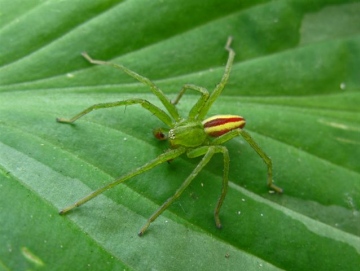Summary for Micrommata virescens (Araneae)
previous species | next species
National Distribution
Terms of Use. Double-click on map to go to region

Explore Regional Distribution
Please log on and add a note on this species
About this species
Recorded altitude range25m to 700m
Species text
DistributionM. virescens is widespread but very scattered in the southern half of Britain, with few records in the north. It is absent from many areas. The species is widespread in western and central Europe but uncommon.
Habitat and ecology
Both sexes are distinctive and are not likely to be mistaken for any other species in Britain. The spider prefers damp sheltered woodland and is often found on the lower branches of oak saplings, on tall grass or sedge tussocks where it sits head down waiting to pounce on passing insects. In mid-summer the female stitches together several leaves to form a relatively large space to enclose the egg-sac (Bristowe 1958). Females are mature from May through to September, but males have a short season and are rare.
Status
Very local and rarer in the north. Although this spider is not that easy to find, in spite of its size and colour, it is unlikely to be overlooked when seen by either general naturalists or arachnologists, and there appears to have been a long term decline.
Threats
The reasons for the decline in this species are unclear, but may be related to general landscape degradation in lowland Britain and fragmentation of semi-natural habitats.
Management and conservation
Maintain landscape scale continuity to woodlands and intervening habitats and ensure woodlands retain open areas through rotational management.
Text based on Dawson, I.K., Harvey, P.R., Merrett, P. & Russell-Smith, A.R. (in prep.). References
Adult Season
Habitats
background methodology
Recorded management for locations with Micrommata virescens
Recorded substrate and hydrology for locations with Micrommata virescens
Images
please log on and upload a new image for this speciesSee also A-Z Species Index - A-Z Picture Index - previous species | next species






